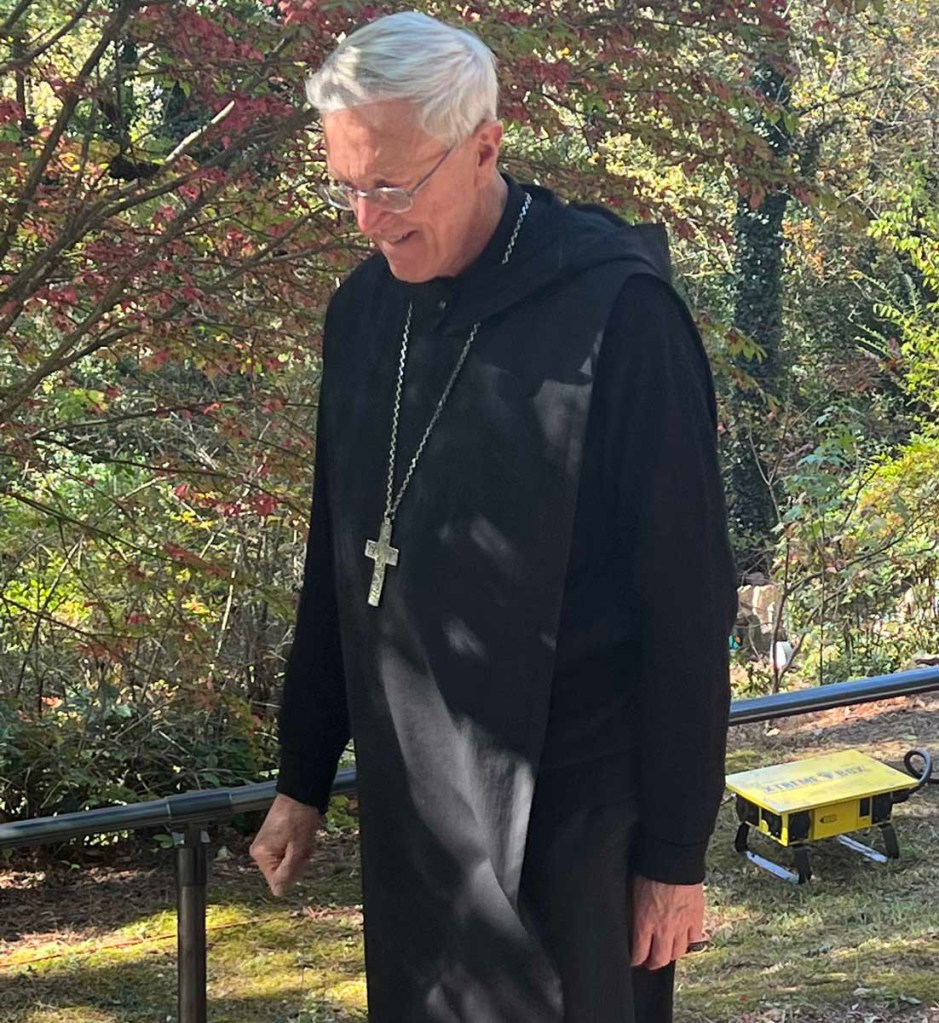Saving history one landmark at a time: Restoration work ongoing at Ave Maria Grotto
Published 12:00 am Thursday, October 27, 2022

- St. Bernard Abbey Abbott Marcus Voss tours Ave Maria Grotto Oct. 21 — tours he led as a young monk in the 1960s — including new hand rails constructed as part of a renovation project.
Weather and time can conspire to degrade and deteriorate even the most well-constructed landmark, and that’s true if that landmark is the Sanctuary of Fatima in Portugal — or a miniature representation of the same in Cullman, Ala.
Ave Maria Grotto is a landscaped, four-acre park situated on a former quarry on the grounds of St. Bernard Abbey. That setting is home to 125 miniature reproductions of some of the most famous religious structures in the world — stone and concrete models that were the lifework of Brother Joseph Zoettl, a Benedictine monk of the monastery who devoted five decades to the project, only stopping his work in 1958 due to poor health.
Constructed largely from refuse — discarded building supplies, bricks, marbles, tiles, pipes, sea shells, plastic statues and animals, costume jewelry and even old cosmetic jars — the grotto is a cornucopia of religious models and icons, a worldwide pilgrimage site that can be toured in an afternoon.
Those who spend an afternoon touring today will find not only miniature reproductions of facilities such as St. Peter’s Basilica, the Monte Cassino Abbey or even more secular sites such as the Leaning Tower of Pisa or a German castle, they will likely come across miniature construction sites and artists such as Allison Bohorfoush or blacksmith Allen Kress, two of a team of artisans working to shore up the damage wrought by decades of Mother Nature’s sun, rain, wind and cold on the outdoor attractions that will draw more than 35,000 visitors annually.
That number of tourists isn’t lost on Renee Welsh, and it fit prominently in her successful visual arts program grant application to the Alabama State Council on the Arts. But the need to renovate the structures of a facility that has been on the national register since 1984 — the grotto was Alabama’s first nomination of a folk art environment to the National Register of Historic Places — was more than that.
“It’s community-driven,” Welsh said. “It’s the passion and love for the grotto of the local people.”
Turning that passion into a call for action, Welsh and others have identified “between 30-35 structures that need love and care and restoration,” beginning with the miniature Die Wald Kapelle — the chapel in the woods.
That chapel is representative of one that the Bavarian-born monk would have been familiar with from his youth, Bohorfoush said. Restoring it has been a nearly three-month process as the Birmingham artist, Kress and stain glass master Tom Dameron work to not only preserve a legacy, but ensure a future.
“I imagine the influence Brother Joseph’s work has had on people that come here from all walks of life, all religions,” Bohorfoush said. “That’s what it’s all about.”
That’s also what it’s “about” for Kress, whose local heritage is built on the grotto.
“I’m full circle,” Kress said. “My great-grandfather and grandfather both worked here. The monks would hire local farmers who would farm in the summertime, but would be hired out in the wintertime when things were slow.”
The slow time meant working in the rock quarry and logging, Kress said, helping to shape the monastery grounds, including what would become the forested trail that encases Brother Joseph’s masterpieces.
“Now, I’m back, 140 years later,” Kress said, and performing work in that same area. In addition to building a needed iron framework for Die Wald Kapelle — “You can’t see it now, but it was pretty close to falling down on itself,” he said. — Kress is also forging and installing new handrails throughout the park, with no detail being too small to overlook.
“I try to blend the new with the old,” Kress said about the railings. “Even the style of the finish, beeswax and linseed oil, is very traditional.”
It’s that tradition that is the most forward-looking part of the project, said Amy Jenkins, visual arts program manager for the Alabama State Council on the Arts.
Jenkins said that the arts council understands that a multi-year restoration of the grotto’s structures is important to not only the abbey, but Alabama.
“This project was very well-reviewed and investigated,” she said. “Ave Grotto is … unparalleled in the state. Saving this art environment is paramount.”
And as for the grant to restore the first part of the project, the chapel in the woods, a multi-tiered review — including approval by the 15-member, governor-appointed council — was just the first of what Jenkins expects will be an ongoing relationship.
“It was a slam dunk, for us, really,” she said about the council funding the project.





